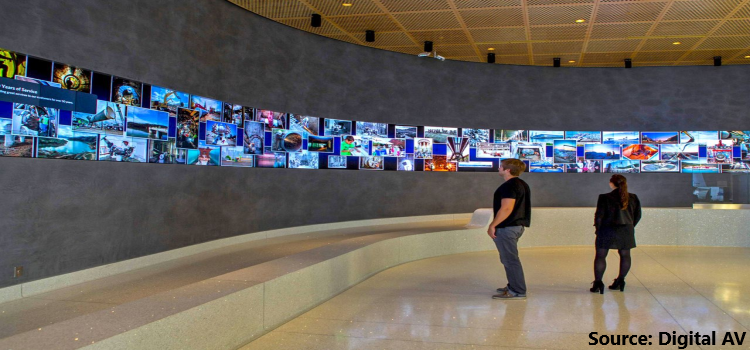Shaping The Future: Top 5 Trends In The Smart Display Industry
Introduction
The smart display market refers to the evolving and dynamic sector of the semiconductor & electronics industry. It focuses on the production, development, and distribution of technologically advanced display devices that incorporate touchscreen interactivity, voice recognition, artificial intelligence (AI) capabilities, and connectivity to the Internet of Things (IoT).
This market encompasses a broad spectrum of applications, including residential homes, commercial spaces, healthcare, automotive, and education. It continues to expand as consumer demand for intelligent and connected display solutions grows. These displays are utilized in various sectors, including residential homes, offices, healthcare facilities, retail, education, and others. From the integration of AI and voice assistants to healthcare applications and beyond, here are the top five trends that are reshaping the smart display landscape.
Integration of AI and Voice Assistants: The integration of artificial intelligence (AI) and voice assistants into smart displays has significantly transformed how users interact with these devices. By incorporating well-known AI technologies such as Amazon Alexa, Google Assistant, and Apple Siri, smart displays have evolved to become responsive to voice commands.
This makes it easier for users to control various functions, including managing smart home devices and providing information and entertainment. The integration of AI equips these displays to provide personalized recommendations and anticipate user preferences based on past interactions, enhancing the overall user experience and tailoring the device to suit individual tastes.
Consequently, this results in a more user-centric and adaptable smart display that can cater to the unique needs and inclinations of each user. For example, Google LLC partnered with the Chinese technology firm Lenovo to develop interactive screens for smart home devices integrated with the Google LLC Assistant. The Lenovo Smart Display seamlessly combines Google LLC services such as Maps, YouTube, Calendar, Duo, and Photos, delivering a comprehensive and user-focused experience. This collaboration exemplifies the growing synergy between AI and smart displays, enhancing their utility in various aspects of daily life.
Healthcare and Telemedicine Applications: The surge in the utilization of smart displays within healthcare and telemedicine is a transformative trend. It is profoundly influenced by the COVID-19 pandemic's emphasis on remote healthcare services. Smart displays are pivotal in reshaping the healthcare landscape, facilitating telehealth consultations, remote patient monitoring, and efficient health data management. These devices have connected patients with healthcare providers in a virtual setting and empowered medical professionals to coordinate care, share vital patient information, and discuss treatment plans in real time.
Furthermore, the seamless integration of smart displays with various medical devices allowed remote patient monitoring, early intervention, and personalized care plans. This makes them particularly valuable for chronic disease management. The adaptability and accessibility of smart displays have not only expanded healthcare services to remote and underserved areas but also ensured that healthcare remains inclusive and accessible to all, underscoring their lasting importance in the healthcare sector. As technology continues to evolve, smart displays are poised to bring further innovations to healthcare, promising improved patient outcomes and enhanced medical services.
For instance, in March 2023, Samsung Electronics America launched the industry's first 4K QLED Smart Healthcare TV. In partnership with ShareSafe, this innovative product transforms in-room displays into versatile communication hubs personalized for hospital patients and senior care residents. This, in turn, leads to improved collaboration, patient engagement, and workflow efficiency.
Gesture and Touchless Controls: Gesture and touchless controls are reshaping the landscape of smart displays by introducing innovative and intuitive means of interaction. These controls offer a hands-free, hygienic, and accessible approach to operating smart displays, particularly valuable in scenarios where physical contact is impractical or undesirable.
Moreover, these controls extend the possibilities of entertainment and gaming, making smart displays a more engaging and immersive platform. As technology evolves, we can anticipate further refinements and diverse applications, ushering in a new era of user-friendly and versatile interaction with smart displays in practical and leisure-oriented settings.
A prime example is Google's smart display lineup, such as Nest Hub and Nest Hub Max, which accept commands with a simple hand gesture. This enhances convenience and underscores the growing significance of touchless controls in shaping the future of smart displays.
Laser-based Display Technology: Laser-based display technology opens up significant opportunities in the smart display market. This technology's remarkable attributes, including its high brightness, precise color reproduction, long-lasting durability, and energy efficiency, position it as a top choice for a wide range of applications. These applications range from home theaters to outdoor signage and augmented reality experiences. Moreover, the extended lifespan and reliability of laser-based displays contribute to lower maintenance costs and align with sustainability goals.
As laser technology becomes more accessible and cost-effective, it drives innovation in the smart display market, especially in sectors where top-tier visual quality and energy conservation are paramount. This trend expands the market's potential for growth. For instance, leading industry players such as Hisense are actively introducing laser technology innovations. In India, Hisense launched its groundbreaking 120-inch 4K smart laser TV, 120L9G. Hisense's commitment to this cutting-edge technology showcases the industry's dedication to pushing the boundaries of smart displays.
Integration in Automotive Applications: The integration of smart displays into automotive applications continues to reshape the driving experience, offering many advanced features. These displays provide state-of-the-art infotainment systems that entertain drivers and passengers on the road with access to streaming media, apps, and voice-controlled interfaces.
Furthermore, they act as robust navigation tools, delivering real-time traffic updates and precise route guidance, reducing travel times and improving safety. Beyond entertainment and navigation, smart displays enhance driver assistance with features such as adaptive cruise control and lane-keeping assist.
They also serve as a hub for connecting to smartphones and IoT devices, further increasing the vehicle's connectivity and convenience. As automakers continually innovate in this space, the integration of smart displays into cars is set to be a crucial factor in shaping the future of the automotive industry, making driving more enjoyable, efficient, and safer than before.
For instance, in August 2023, BMW partnered with Samsung to develop display technology for its subsidiary MINI's vehicles. The MINI Interaction Unit, a circular 9.4-inch OLED display, will be centrally positioned on the dashboard of MINI cars. This high-tech display is an intelligent computer running on the Android-based MINI 9 operating system. It offers features, including a GPS navigation system and a smart voice assistant, enabling control over music playback, message sending, route adjustments, and others.
This partnership highlights the growing importance of advanced display technology in the automotive sector. BMW and Samsung's innovation is likely to set new standards, driving the adoption of smart displays in the broader automotive industry, and by extension, stimulating the growth of the smart display market.
Authors View Point
The impressive growth anticipated in the smart display market is a testament to the ever-evolving landscape of technology along with these top trends and consumer preferences. As the lead analyst at Next Move Strategy Consulting, I've observed this market's trajectory closely. To put it in perspective, the smart display market was valued at USD 12.71 billion in 2022, and it is poised to reach a remarkable USD 48.02 billion by 2030, with a compelling CAGR of 16.5% from 2023 to 2030.
However, it is vital to acknowledge the recent geopolitical developments, notably the ongoing crisis in Russia and Ukraine, which has led to significant repercussions in the tech industry. The exit of key players such as Google, Samsung, and Sony from the Russian market introduced uncertainty. This withdrawal, driven by geopolitical concerns, threatens to disrupt the supply chains that provide critical components for smart displays. This disruption can result in shortages and increased production costs for the industry.
The departure of these tech giants introduces an element of unpredictability into the smart display market. It may affect the confidence of investors, manufacturers, and consumers in the sector, potentially slowing down investments and impeding the market growth.
In conclusion, the smart display market's impressive growth is a clear indication of a promising future for smart display technology and its capacity to meet the changing needs of consumers. The interplay of these key trends with the market's expansion is undeniable, shaping how we interact with technology, access healthcare, automate our homes, and enjoy immersive experiences. The smart display industry is unquestionably leading the charge in technological evolution, promising a future that is more interconnected, user-focused, and efficient than before.
About the Author
 Sikha Haritwal is a researcher with more than 3 years of experience. She has been keeping a close eye on several industry verticals, including Banking, Financial Services, and Insurance (BFSI), personal care products, and consumer electronics. She has avid interest in writing news articles and hopes to use blog as a platform to share her knowledge with others. When she is not following industry updates and trends, she spends her time reading, writing poetry, cooking, and photography. The author can be reached at sikha.haritwal@nextmsc.com.
Sikha Haritwal is a researcher with more than 3 years of experience. She has been keeping a close eye on several industry verticals, including Banking, Financial Services, and Insurance (BFSI), personal care products, and consumer electronics. She has avid interest in writing news articles and hopes to use blog as a platform to share her knowledge with others. When she is not following industry updates and trends, she spends her time reading, writing poetry, cooking, and photography. The author can be reached at sikha.haritwal@nextmsc.com.


Leave a Reply